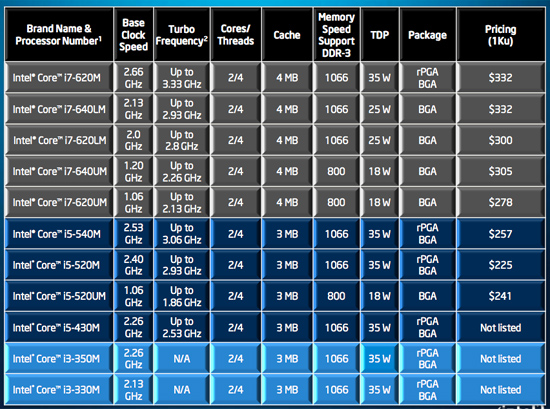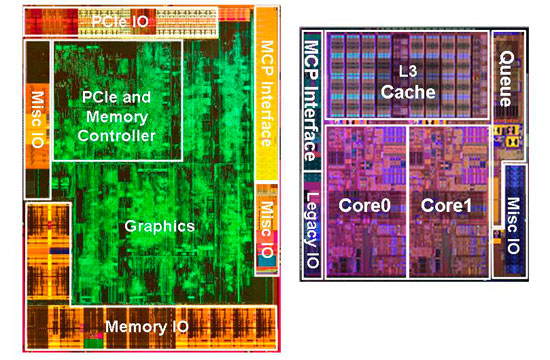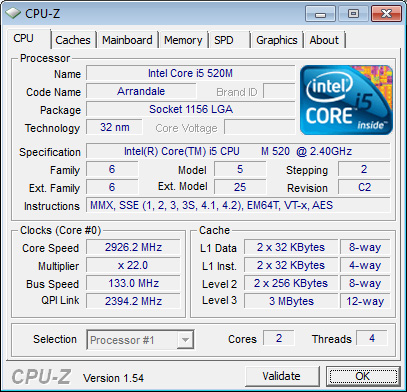Apple's 15-inch Core i5 MacBook Pro: The One to Get?
by Anand Lal Shimpi on April 14, 2010 10:38 PM EST- Posted in
- Mac
- MacBook Pro
- Arrandale
- Core i5
- Laptops
Faster, Not Slower
The 15-inch and 17-inch MacBook Pros offer your choice of Core i5 or i7 processors. If you follow Intel’s model numbers, you can get either a Core i5 520M, 540M or Core i7 620M. These chips run at 2.40GHz, 2.53GHz or 2.66GHz by default.
Wait! But the old 15-inch MacBook Pro ran at 2.53GHz, 2.66GHz or 2.80GHz by default. These new models are slower! After reading that a few times online yesterday, I knew it was time for a quick refresher on microprocessor architecture and performance.

Intel's Arrandale Lineup
There are three ways we can improve CPU performance these days: increase clock speed, increase IPC or increase thread count. The first improvement is the obvious one. Keep all other variables the same, just make the chips run at a higher frequency. The second one requires that we increase the amount of work our CPU does in each clock cycle (increasing the number of instructions completed per clock, or IPC). And the third one is to simply increase the number of simultaneous threads our CPU can handle, either through multiple cores or multiple threads per core.
With Arrandale, the mobile Core i5 and i7, Intel actually used all three tricks to improve performance.
I’ll start with the middle improvement: increasing IPC. Arrandale brings a dual-channel memory controller on-package (it’s actually on the GPU and not the CPU as you may remember). This improves bandwidth which in turn keeps the CPU cores fed with data and thus increases overall IPC.

The Arrandale die. Graphics on left, CPU on right.
The cache hierarchy has changed quite a bit since the Core 2 days. Instead of a large shared L2 cache, each of the two Arrandale cores have their own private 256KB L2 cache. The cache is the fastest of any desktop CPU today requiring only 10 cycles to access it. As I wrote in the past, the L2 is quickly becoming the new L1 so low latency access matters more than size. The catch-all cache moves down a level and Arrandale has a large 4MB L3 cache. On the Core i7s you get the full 4MB, while the i5s disable 1MB leaving you with 3.

There are some instruction and execution level improvements as well, which I’ve detailed here and here. Specific to Arrandale (and the rest of the Westmere family) are new AES instructions designed to accelerate encryption/decryption operations.
The takeaway here is any slight drop in default clock speed is at least partially negated by the increase in performance per clock. If that’s not enough, Arrandale also brings Turbo Boost to Intel’s mobile chips.
These Core i5 and i7 processors have about a million transistors dedicated to power management. It’s a little section of the CPU called the PMU (Power Management Unit). The PMU monitors CPU temperatures, current draw and power consumption. Based on these inputs as well as the current load on the CPU, the PMU can tell the rest of the CPU to increase its clock frequency. The CPU is allowed to increase its operating frequency in 133MHz steps up to a predefined max speed. The max speed is determined by Intel as well as the number of cores that are actively doing work on the chip.
The whole process works like this. If you have all cores active and the workload they’re running isn’t maxing out the CPU’s specified current or power draw, the cores can run at a higher frequency. If you have only one core active, the other core is power gated (effectively shut off) and the active core is allowed to turbo up several bins as long as it remains within its current, temperature and power limits.
The result is that most of the time your 2.40GHz Core i5 runs at 2.66GHz, and if you’re only running single threaded applications you’ll see it bounce from 2.66GHz to 2.80GHz and 2.93GHz. So even if the IPC improvements brought on by Arrandale weren’t enough, you’ll rarely run at your base clock speed when you need the performance. Intel’s Turbo Boost works beautifully in practice and the transition to OS X seems to have gone well.

The 2.40GHz MacBook Pro running at 2.93GHz thanks to Turbo
The final vector for performance improvement is by increasing the number of threads your CPU can work on at once. Threads are nothing more then collections of instructions, which themselves are the basic work units of any CPU. The more threads you can actively complete in parallel, the higher your overall CPU performance.
All Arrandale based Core i5 and i7 CPUs are dual-core processors, that’s two threads right there. Each core however can work on two threads at the same time thanks to Intel’s Hyper Threading bringing us up to four total threads on the new MacBook Pro. Two of those threads are virtual and are simply designed to occupy any idle resources on a core. Hyper Threading doesn’t give the same performance boost as you’d get from four cores, but what it does give you is better-than-dual core performance without the power requirements of four physical cores. For a notebook designed with portability in mind, the tradeoff is ideal.

The downside to all of this? Only the 15-inch and 17-inch models get Arrandale, the 13-inch MacBook Pro sticks with the old Penryn derived Core 2 Duo architecture. If you were holding out for a 13-inch Arrandale model, you’ll have to keep waiting.
| Apple's 2009 Lineup | 13-inch MacBook Pro (Early 2010) | 13-inch MacBook Pro (Late 2009) |
| CPU | Intel Core 2 Duo 2.40GHz | Intel Core 2 Duo 2.26GHz |
| Memory | 4GB DDR3-1066 | 2GB DDR3-1066 |
| HDD | 250GB 5400RPM | 160GB 5400RPM |
| Video | NVIDIA GeForce 320M (integrated) | NVIDIA GeForce 9400M (integrated) |
| Optical Drive | 8X Slot Load DL DVD +/-R | 8X Slot Load DL DVD +/-R |
| Screen Resolution | 1280 x 800 | 1280 x 800 |
| USB | 2 | 2 |
| SD Card Reader | Yes | Yes |
| FireWire 800 | 1 | 1 |
| ExpressCard/34 | No | No |
| Battery | 63.5Whr | 60Whr |
| Dimensions (W x D x H) | 12.78" x 8.94" x 0.95" | 12.78" x 8.94" x 0.95" |
| Weight | 4.5 lbs | 4.5 lbs |
| Price | $1199 | $1199 |










114 Comments
View All Comments
oldbriones - Thursday, April 15, 2010 - link
I am disappointed, once again, that apple slapped on crappy TN panels to their MacBook Pro.Use of IPS panels in iPad, new iMacs, and new Cinema Displays were welcome changes for the better
(far superior viewing angle, color integrity). Why not in the Pro line of MacBook ?!
beginner99 - Thursday, April 15, 2010 - link
to increase margins. fanboys will buy it anyway (no sane person would for this price...)It's like 800$ extra compared to similar dell, hp,... models.
that_guy_mike - Thursday, April 15, 2010 - link
by that logic no one would drive a mercedes or bmw either since you can get a honda for way less, and they're clearly the same since they are all just cars.The0ne - Thursday, April 15, 2010 - link
That's retarded. When referring to laptop the margins/difference in hardware and much less than comparing vehicles. It's the same hard drive, same memory, etc. A car may be a car but the process of getting there is absolutely different, less being the same part.Now if you were to say, why not buy a car with almost the same parts and materials, slap on a Mercedes logo, and charge a premium for it then that would make more sense.
mikesmithson - Friday, April 16, 2010 - link
You mean how like the difference between a Honda Accord and an Accura TL? Like how they use a lot of the same parts... Accord starts at $21,000; TL at $35,000...maler23 - Thursday, April 15, 2010 - link
Prolly the odd man out, but I'm waiting for a review of the 13 inch model. I was already pretty much decided on the MBP 13in anyways, so any upgrades for the same price is a perk.The lack of Arrandale kinda hurts though; I'm also wondering if the nVidia 320M makes things run any hotter. I'd love to hear a good reason why Apple skipped the Core i3 and stuck with the Core Duo. I'm assuming it was a space concern due to the whole Intel/NVidia chip kerfuffle and they wanted to keep the same sized chassis?
Anand, any bets on an Arrandale update for the Fall for the MBP 13?
cheers!
-J
solofest - Thursday, April 15, 2010 - link
I second the request for a 13" review. I'd like to see how the 320M stacks up, as well as some real world battery tests. Re: an Arrandale update for the 13" in the fall, sounds like Apple may as well wait until Sandy Bridge?solipsism - Thursday, April 15, 2010 - link
Ditto.The tests of Core-i3 and having to use Intel HD over a speed bump in C2D and Nvidia 320M tell me that Apple made the right choice. I can't see the 13" MBP maintaining the same price point or increasing the battery duration with a discrete GPU.
I think Anand is correct in that the a Fall release is inevitable. While this is is a decent update I think it is meant to be a stopgap for more radical changes. What should have come about 7-8 months later may jut 4-6 months later due to the Arrandale supply issue.
For the next release, the 13" MBP may have to drop the ODD to make room for the component and cooling, and to lessen the blow of the GPU cost. Apple obviously isn't going to offer Blu-ray so I'd say they are just holding onto the internal ODD until offering Mac OS X Restore Discs on a 16GB SD Card is more viable. I don't think they added SD to the 13" and 15" so many years after it was standard, just to say "me too". I think it'll be the new way to restore the disc. It's how I've been doing it for a couple years.
PS: I wish Anand would have mentioned the other aspects of this revision: audio over DisplayPort or HDMI, and force accelerated scrolling.
PPS: I don't recall seeing any mention of how Nvidia Optimus doesn't power down the IGP when the GPU is active. I'd like to see the power usage differences between Windows and Mac OS X on these machines now that Apple has graphics switching in place. It's too bad Optimus won't work under BootCamp.
Affectionate-Bed-980 - Thursday, April 15, 2010 - link
How easy is it to replace HDs in the new unibody MBPs? I have a 2008 MBP (15") and it takes a great amount of work to disassemble just to change out a hard drive. With HD prices so cheap, it's not too hard to buy a 500gb 7200 RPM drive and stuff it in. However, I'm often discouraged when it takes a lot of tampering. I've disassembled my Wii to mod chip it. I've disassembled camera lenses to blow out dust behind the front element, but I'm not the most hands on guy and I hate repacking things together. I often mess up there.solipsism - Thursday, April 15, 2010 - link
It's pretty simple. Check iFixit for the 2009 MBPs. You basically take the entire bottom off, about 10 screws, and then a 1-3 screws for the HDD. It'll takes you an extra 2 minutes over the previous models with the latch and door exposing the HDD and battery.